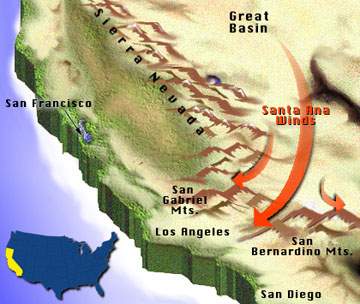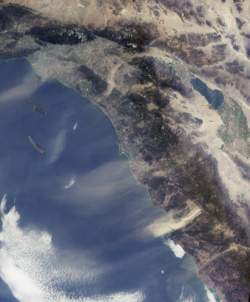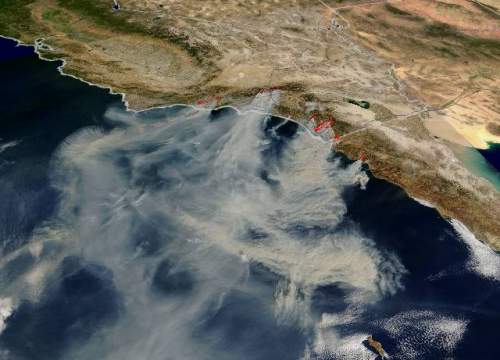Weather Almanac for September 2006
THE SANTA ANA: CALIFORNIA'S EVIL WIND

Southern Californians experience some of the most consistent warm and sunny weather in the United States without the heat and humidity of the more tropical areas of the nation such as Florida and Hawaii. But each year, usually between October and February, they may experience a most unwelcomed hot and dry wind: the Santa Ana.
The Santa Ana winds are the cousins of the chinook winds of the Rockies, of the family known to meteorologists by their alpine name: the foehn winds, hot and dry winds descending mountain slopes. They are warm and dry because their air has been warmed by compression as they flow down the leeward mountain slopes. Whereas the chinook winds blowing down the Rocky Mountains usually begin as colder air that is then warmed by the compression, the Santa Ana winds are often already warm and definitely dry as they descend from the high desert down the San Gabriel and San Bernardino Mountains into the Los Angeles Basin.
These winds, which get their name from the Santa Ana Canyon (but more on that later), are most frequently experienced during December and are rare in the summer. Besides their discomforting heat and dryness, the Santa Ana winds are strongly associated with high fire danger, particularly in the chaparral brush growing on the Southern California mountain slopes. For this reason they are often called devil winds or devil's breath.
Weather Scenario for the Santa Ana Winds
Most commonly, the Santa Ana winds arise when high pressure builds over the high plateau regions of Nevada and Utah, east of the Sierra Mountains and west of the Rockies. The pressure gradient between this region and the Pacific coastline produces winds that move out of the high plateau toward lower pressure over the Pacific Ocean. As it descends to the coast, the air heats due to the compression of moving from the higher elevation to that at sea level. The heating of the air amounts to about 9.8 Celsius degrees per 1000 metres of descent (5.4 Fahrenheit degrees per 1000 feet). And as this desert air heats, its relative humidity drops further making it drier still, often to less than 15%. (Occasionally, the Santa Ana wind is cold, relatively speaking, because the air's true origin was in the polar and subpolar regions before moving to the high plateau.)

Diagram courtesy of California Applications Program, NOAA Office of Global Programs
The complex topography of the San Gabriel and San Bernardino mountain ranges forces the descending, seaward moving air through many passes and canyons, one of which is the Santa Ana Canyon. The Santa Ana winds reaching the Los Angeles Basin and San Diego County typically blow from the north to east and can reach high speeds. Local National Weather Service forecasters usually hold off calling winds Santa Ana winds until their speed exceeds 25 knots (28 mph / 46 km/h). Forcing the air through mountain gaps may further increase the wind speed. Therefore, Santa Ana winds may blow at sustained speeds of 40 mph (65 km/h) with gusts of 70 mph (112 km/h) and at times reaching 115 mph (185 km/h).
Air temperatures under Santa Ana wind events can rise over 100 oF (37.8 oC). Historical reports from the Santa Barbara region indicate a temperature of 133 oF (56 oC), was unofficially measured on June 17, 1859 just offshore during a Sundowner wind event (the local name for a Santa Ana wind). However, the accuracy of the reading could not be verified, and the official high for the region is 109 oF (43 oC). In September 1979, temperatures at San Juan Capistrano topped 100 oF (37.8 oC) for 10 consecutive days during a mild Santa Ana wind event.
 |
View of California Coast
during Santa Ana Event
shows pattern of airborne dust
stirred up by Santa Ana winds
Image (2002) from the Multi-angle Imaging SpectroRadiometer
Courtesy NASA
GSFC/LaRC/JPL, MISR Team. |
Often, the Santa Ana winds blow stronger during the night. The reason is that during the day, the downslope winds are often opposed by a sea breeze moving off the colder Pacific waters into the hot basin. At night, when the sea breeze dies, the Santa Ana winds may down the mountains unopposed.
Santa Ana winds are best known for their spreading of wildfires, but other hazards are associated with the winds as well. Many believe the hot, dry winds alter people's moods and lead to increases in angry or violent behaviour, an effect similarly attributed to hot, dry winds in southern Europe such as the sirocco. They may also cause wind damage to property and enhance turbulence levels and low-level wind shear for aircraft. As the winds move offshore, they can present a hazard to boater, often bringing unusually high surf along the northeastern side of the Channel Islands. Of course, the higher waves also attract the legendary Southern California surfer.
Santa Anas can bring positive effects too. Oceanographers note that when Santa Anas blow offshore, the sea surface temperature drops by about 4 C degrees (7 F degrees). That may seem counter-intuitive since the Santa Ana winds are hot winds, but the drop in sea-surface temperature indicates that the winds are causing an upwelling of colder water from ocean depths. This water contains a higher level of nutrients than the normal surface waters, which gives rise to an increase in biological process that can benefit local fisheries.
The Santa Ana may also blow the smog out from the Los Angeles Basin increasing the visibility, but if the winds are associated with wildfires, the local visibility does not always improve.
Fire!
The Santa Ana season (period of its most frequent occurrences) begins in the autumn following the dry Southern California summer. Blowing hot, dry air over already tinder-dry chaparral causes local residents and officials great concern as fire risk levels skyrocket. Once fires start, Santa Ana winds will fan the flames, quickly spreading them across vast acreage.
Nearly every year, devastating wildfires break out across this region of Southern California. For example, Santa Ana winds during October 2003 fanned wildfires that burned 721,791 acres (2,921 kmē), destroyed 3,640 homes, and killed 14 over two weeks. One of the fifteen fires that burned during this period, the Cedar Fire, is acknowledged to be the second largest wildfire in the history of California.
The Cedar Fire in the late afternoon of 25 October south of Ramona in central San Diego County. Overnight, the rampaging wildfire killed 13 people living north of Lakeside who had little or no warning of its approach. In less than 17 hours, the Cedar Fire spread over 30 miles (48 km) to the southwest, burning over 100,000 acres (405 kmē) at a rate of 5,000 acres (20 kmē) per hour. By the time it died out, the Cedar Fire consumed 280,278 acres (1,134 kmē), 2,820 buildings (2,232 homes) and had killed 14 including one firefighter.

Southern California ablaze on October 26, 2003. The massive Cedar Fire's thick smoke overshadows the coastal city of San Diego. Other fires seen in the picture from northwest to southeast: the Piru, Verdale, and the Simi Incident Fires; east of Los Angeles, the Grand Prix (west) and Old (east) Fires; To their south is the Roblar 2 Fire; next is the Paradise Fire. At the California-Baja California border is the Otay Fire. The southernmost plume of smoke is from a fire in Baja California.
Satellite photo courtesy NASA/Goddard Space Flight Center Scientific Visualization Studio
The Cedar Fire was not the only one burning Southern California that day. Massive wildfires also broke out in Ventura, San Bernadino, and San Diego counties almost simultaneously. The Old Fire, the largest fires in San Bernardino County ravaged over 150,000 acres. The Piru Fire and Simi Incident Fire in Ventura County scorched a total of about 200,000 acres. The Paradise Fire outside San Diego burned 51,000 acres.
Naming The Wind
I know of no other local wind name that seems to have more confusion about its name. First, there appears to be another name that some call this wind — the Santana wind — that can easily be confused, because Santana and Santa Ana are very close in pronunciation. Another variation is Satana, meaning Satan in Spanish, and often the Santa Ana feels like it is blowing directly from the realm of Satan, particularly when it is sweeping a fire front with it.
The origin of the name also has many variations. Bertram B. Moore wrote on these in an article "The Santa Ana Winds" published in San Diego Historical Society Quarterly. Moore states that some believe the name derives from the famed Mexican general and president, Antonio Lopez de Santa Anna (best known in the USA for his part in the fight for Texas and the Battle of the Alamo) but Terry E. Stephenson, in a paper in the California Folklore Society Quarterly (February 1943) discounts this origin because the winds were called Santa Ana winds well before the general became famous.
Another widely held belief is that the name stems from a local Indian word santana meaning bad or big wind. However, Moore reported that Professor Harry Hoifer, an eminent authority on Indian languages of Southern California, was unable to locate "any word even remotely similar to the word Santana, big or bad winds" in the native language database.
The majority of chronicles place the origin of the name in the Santa Ana Valley/Canyon from which the winds blew on the early settlers of the area, and this has become the most accepted origin of the name.
Finding A Place In Popular Culture
The Santa Ana winds are famed for their impacts on Southern California and have moved from the news pages to the avenues of popular culture as well. Many of the literary works use the wind's notoriety for adversely affecting people's mental state as part of the plot line.
In 1938, famed mystery writer Raymond Chandler penned a short story entitled "Red Wind" published first in Dime Detective Magazine and currently found in the collection: Raymond Chandler: Collected Stories. Red Wind is another local name for the Santa Ana wind. The Chandler story has been dramatized on television and radio, most recently as a 1996 episode on Showtime's Fallen Angels. Danny Glover received an Emmy nomination for his role in this adaptation playing detective Philip Marlow.
In the story, Chandler describes the Santa Ana thus:
"There was a desert wind blowing that night. It was one of those hot dry Santa Anas that come down through the mountain passes and curl your hair and make your nerves jump and your skin itch. On nights like that every booze party ends in a fight. Meek little wives feel the edge of the carving knife and study their husbands' necks. Anything can happen. You can even get a full glass of beer at a cocktail lounge."
"Red Wind" (1938)
Writer Joan Didion began her book Slouching Towards Bethlehem (1968) with the following description of the Santa Ana winds.
"The San Bernardino Valley lies only an hour east of Los Angeles by the San Bernardino Freeway but is in certain ways an alien place: not the coastal California of the subtropical twilights and the soft westerlies off the Pacific, but a harsher California, haunted by the Mojave just beyond the mountains, devastated by the hot dry Santa Ana wind that comes down through the passes at 100 miles an hour and whines through the eucalyptus windbreaks and works on the nerves. October is the bad month for the wind, the month when breathing is difficult and the hills blaze up spontaneously."
And later adds:
"There is something uneasy in the Los Angeles air this afternoon, some unnatural stillness, some tension. What it means is that tonight a Santa Ana will begin to blow, a hot wind from the northeast whining down through the Cajon and San Gorgonio Passes, blowing up sand storms out along Route 66, drying the hills and the nerves to flash point."
In White Oleander (1999), Janet Fitch uses the Santa Ana as a major device in the plot. She writes of the wind and its effect on the human psyche:
"The Santa Anas blew in hot from the desert, shriveling the last of the spring grass into whiskers of pale straw. Only the oleanders thrived, their delicate poisonous blooms, their dagger green leaves. We could not sleep in the hot dry nights, my mother and I. I woke up at midnight to find her bed empty. I climbed to the roof and easily spotted her blond hair like a white flame in the light of the three-quarter moon."
Elizabeth M. Cosin's 1999 detective novel Zen and the City of Angels parallels Chandler's description of the wind:
"The Santa Anas have a lot to do with this, dragging thick, hot winds across the Southland with such ferocity they seem to pick up every free particle that's not nailed down. It makes for some uncomfortable weather, the kind that gets up your nose, into your eyes and underneath your skin."
But not all written about these winds is unfavourable. Jessamyn West recalled her childhood views on the Santa Anas in her autobiography To See the Dream (1957):
"Recently, reading Guy Murchie's The Song of the Sky, I had the most — maternal, I think, is the word — pleasure in finding the Santa Ana, the much-loved wind of my girlhood, listed among the great winds of the world. I smiled with all the fondness of a mother who sees by the papers that her daughter has been elected homecoming queen. Local wind makes good! My Santa Ana listed and defined. For the Santa Ana, I discovered, is a "down wind," very treacherous, a wind that caused more air accidents than any other. I never knew in my girlhood that the Santa Ana was a "down wind," a wind falling off the mountain heights into valleys; but I did know, when the green-gray dust cloud, which presaged its coming, rose like a pillar sixty miles away, anticipations of great joy. Ranchers and housewives hated the Santa Ana. But its coming was a lark for childrenor made children larks. We fashioned sails, kitelike of paper, or shiplike of cloth, and abandoned ourselves to its power; and if we were not lofted like birds we were at least winged and wind-propelled."
Popular music also brings the Santa Ana winds to listeners, directly and indirectly. The Doors reference it in their song "LA Woman:" "...see which way the wind blows...[the city's] hair is burnin' hills are filled with fire..."
Reference is made to Santa Ana winds in songs recorded/written by Belinda Carlisle, Poco, Randy Newman, Steely Dan, Elton John, Paul Cotton, and Bad Religion. The Beach Boys, Steve Goodman, and Survivor each wrote songs entitled "Santa Ana Winds."
The Beach Boys: "Santa Ana Winds" from 1980 album Keepin' the Summer Alive.
"Here in Southern California there is a weather condition known as the Santa Ana Winds.
Fire wind oh desert wind
She was born in a desert breeze
And winds her way
Through Canyon Way
From the desert to the silvery sea"
I am sure there are many other songs with references to the Santa Ana winds. And, like the classical ensemble The Wreckhouse Winds, the is at least one group to derive its name from these winds: The Santa Ana Winds Youth Band, the "Official Music Ambassadors for Orange County, California."
Learn More From These Relevant Books
Chosen by The Weather Doctor
Written by
Keith C. Heidorn, PhD, THE WEATHER DOCTOR,
September 1, 2006
The Weather Doctor's Weather Almanac The Santa Ana: California's Evil Wind
©2006, Keith C. Heidorn, PhD. All Rights Reserved.
Correspondence may be sent via email to: see@islandnet.com.
For More Weather Doctor articles, go to our Site Map.

I have recently added many of my lifetime collection of photographs and art works to an on-line shop where you can purchase notecards, posters, and greeting cards, etc. of my best images.

Home |
Welcome |
What's New |
Site Map |
Glossary |
Weather Doctor Amazon Store |
Book Store |
Accolades |
Email Us
|



|










